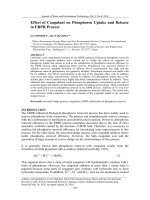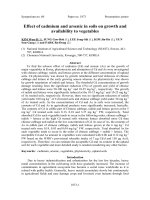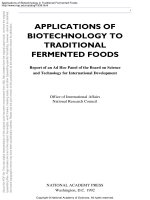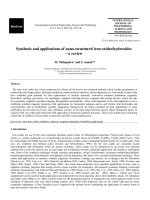A review on applications of carbon nanotubes in automobiles
Bạn đang xem bản rút gọn của tài liệu. Xem và tải ngay bản đầy đủ của tài liệu tại đây (515.05 KB, 7 trang )
International Journal of Mechanical Engineering and Technology (IJMET)
Volume 11, Issue 1, January 2020, pp. 204-210, Article ID: IJMET_11_01_018
Available online at />ISSN Print: 0976-6340 and ISSN Online: 0976-6359
© IAEME Publication
A REVIEW ON APPLICATIONS OF CARBON
NANOTUBES IN AUTOMOBILES
Akshay Krishnan, Sarthak Shandilya, Balasubramanya H S and Pushparaj Gupta
Department of Mechanical Engineering, Ramaiah Institute of Technology,
MSR Nagar, Bengaluru, India
ABSTRACT
The Automotive industry continues to be a budding and growing industry wherein
new and innovative ideas and technologies find very promising applications
periodically. This review paper to a great extent will look into the relevance of carbon
nanotubes as a way to improve the performance of “on the road” automobiles in the
field of fuel component systems particularly to get a better fuel efficiency. Further the
implementation of Carbon Nanotubes shall be dealt in depth with a focus on
automobile application. Furthermore, CNTs have been found to have exceptional
morphological properties and therefore are promising as reinforcement material in
the composite structures along with polymers for many automotive applications. This
could also become the basis for weight reduction. Needless to say, CNTs can be
utilised for the production of geometrical, irregular or complex shapes and designs
with fairly inexpensive and relatively abundant raw materials vis a vis the current
conventional processes of fabrication. Therefore cost effectiveness and productivity
could also be achieved in scale and scope.
Keywords: Carbon Nanotubes, Automobile, Fuel Efficiency, Nanotechnology.
Cite this Article: Akshay Krishnan, Sarthak Shandilya, Balasubramanya H S and
Pushparaj Gupta, A Review on Applications of Carbon Nanotubes in Automobiles.
International Journal of Mechanical Engineering and Technology 11(1), 2020,
pp. 204-210.
/>
1. INTRODUCTION
Carbon nanotubes or CNTs basically consist of rolled up sheets of single layered carbon
atoms (graphene). Further Carbon nanotubes can be categorised as [1,14]: Single Wall Carbon
Nanotubes (SWCNT) [Fig(1)], Double Wall Carbon Nanotubes (DWCNT) [Fig(2)] & Multi
Wall Carbon Nan- otubes (MWCNT) [Fig(3)]. SWCNT can reach diameter less than 1
nanometer. DWCNT has one nanotube nested within another. The nanotube inside has a
smaller diameter. The spatial gap between the two diameters results in the varying
interactions between the nanotubes. This means that the outer nanotube can be modified
without any modifications in the inner nanotube and therefore this results in interesting
characteristics. MWCNT consists of several concentrically interlinked nanotubes which can
reach diameters more than 100 nanometers.
/>
204
A Review on Applications of Carbon Nanotubes in Automobiles
Historically, progress of automotive industry is replete with outstanding examples of new
materials and usage of their properties to bring about disruption in the trend. Therefore, to
have better cars in the future our industry needs to change and it needs to change for the
better. The rapid progress of CNTs shows great promise for the betterment of this industry.
The main reasons for using CNTs is due to its extraordinary properties are High flexibility
without any significant damage, Low Thermal Expansion Coefficient, Very High Tensile
Strength. Each of the above mentioned properties in its own respect can merit a lot of usage
and in combination can be used to improve the efficiency and structural characteristics of the
car.
2. SYNTHESIS OF CARBON NANOTUBES
The most popular mode of producing high volume CNTs is by using Chemical Vapour
Deposition (CVD) which generally uses fluidised bed reactors as from Fig.(1) that allows
uniform gas diffusion and heat transfer to metal catalyst nanoparticles. Scaling up the
production can be done with the help of low cost feed stocks [1,6,15]
Figure 1 Chemical vapor deposition
Whereas to produce small sample sizes, solution blending proves to be a very effective
production technique [Fig(2)]. It is a three step process involving dispersion of nanotubes in
suitable solvent, mixing with polymer and then recovering the composite by casting a film.
[2]
Figure 2 Solution blending
/>
205
Akshay Krishnan, Sarthak Shandilya, Balasubramanya H S and Pushparaj Gupta
3. NITROGEN DOPED CNT EFFECT ON FUEL CONSUMPTION
The current industry application of fuel cells has been to use the more expensive platinumbased electrocatalysts for oxygen reduction reaction (ORRs). One of the basic tenets of
manufacturing is mass production resulting in a more cost effective product. Current fuel cells
are no exception to this rule. However CNTs have the potential to further make manufacturing process cost efficient through increased productivity. Experiments have been
conducted through introduction of dopants to validate the above claims. [3,5]
Nitrogen doped Carbon Nanotubes (VA-NCNTs), which are Vertically Aligned, can act as
a metal-free electrode with a much better electrocatalytic activity and a stabilising the process
over a period of time. Synthesis of this fuel cell can be achieved by a similar way with the
help of Chemical Vapour Deposition (CVDs) or high-temperature and high- pressure
reactions.[4]
Alternatively pyrolyzing melamine under Ar at elevated temperatures of 800–980 ◦C
using the CVD method can also be used to produce NCNTs. However this method does not
produce the desired configuration of the NCNTs. It will pro- duce a bamboo like structure
which affects the configuration of nitrogen when introduced and hence producing properties
not meeting the required standards. [4]
Nitrogen Doping has a very important role in lithium ion batteries because NCNTs are
much more reactive to metal oxide nanoparticle deposition which in turn further enhance the
storage capacity. Therefore by having many favourable N- doped sites the storage capacity of
the battery also increases. The above data shows experiments conducted on VA- NCNTs vs
Conventional cells a poison methanol was introduced to the fuel cells, methanol and Carbon
monoxide. [4]
Figure 3 A: I-t Chronoamperometric values procured at the VA- NCNT/GC electrode when
introduced to Methanol.
Figure 3B: I-t Chronoamperometric values procured at the Pt- C/GC electrode when introduced to
Methanol.
/>
206
A Review on Applications of Carbon Nanotubes in Automobiles
Figure 3C: I-t Chronoamperometric values for the Pt-C/GC and VA-NCNT/GC electrodes when
introduced to CO.
Figure 3 (A), (B) and (C) shows I-t characteristics for different electrode materials introducing into
meehanol. The graphs demonstrate that VA-NCNT as better stability characteristics compared to PtC/GC.
4. CNT COATINGS
CNT Coating is turning out to be one of the best coatings finding its usage in numerous ways.
It not only has high anticorrosive properties but also provides additional strength and stiffness
while still having cathodic protection. As time is running out so is our resources and the
scarcity of Indium is making the production of Indium Tin oxide (ITO) much more expensive.
The usage of CNT coating because it is more flexible, transparent and, less brittle as
compared to ITO, will soon come out of R&D laboratories to the production processes in the
automobile industry, thus transforming from and idea to a reality. [6]
These appealing properties of CNTs can be implemented to the automobile industry to
create a long lasting chassis and body which will not corrode under extreme conditions. CNT
Coating is turning out to be one of the best coatings finding its usage in numerous ways. It not
only has high anticorrosive properties but also provides additional strength and stiffness while
still having cathodic protection. As time is running out so is our resources and the scarcity of
Indium is making the production of Indium Tin oxide (ITO) much more expensive. The usage
of CNT coating because it is more flexible, transparent and, less brittle as compared to ITO,
will soon come out of R&D laboratories to the production processes in the automobile
industry, thus transforming from and idea to a reality [Fig. (4)] [6]. These appealing properties
of CNTs can be implemented to the automobile industry to create a long lasting chassis and
body which will not corrode under extreme conditions.
Figure 4 Surface coating on CNT
/>
207
Akshay Krishnan, Sarthak Shandilya, Balasubramanya H S and Pushparaj Gupta
5. MECHANICAL PROPERTIES OF CNTS
Mechanical properties of materials play a pivotal role in improving the form and function of
an automobile. Historically the automobile companies use alloy steel for its body and have
been no doubt very successful but the industry is still looking towards how to tackle with
corrosive properties of steel. The alternative to steel, because of its heaviness, is to use
aluminium but this replacement can happen making it expensive. Here comes the usage of
CNTs, because of its strength, hardness and bending properties, better than both steel and
aluminium and also cheaper than two metals.
6. STRENGTH OF CNTS: [7,9,10]
As per industry standard Young’s modulus is used as a measure of strength and CNT is found
to be stronger than steel and aluminium. Further, the cylindrical graphitic structure makes the
entire body seamless and defect-free. Environmental factors such a temperature changes,
pressure, moisture, etc, while selecting the material, conducting experiments and doing
comparative analysis of CNT with respect alloy steel and aluminium. These factors have a
considerable bearing and directly affect the structural integrity of the material.
Further, one needs to take into consideration whether the material is brittle and ductile. While
conducting experiments, fracture stress becomes the criterion for brittle and yield stress
becomes the criterion for ductile materials. At a micro level the strength and the breaking
mechanisms of any material depend on the movement of the dislocations present within.
7. CNTS HARDNESS:[11,12,13]
Single Walled Carbon Nanotube, do not show any plastic deformation up to 25GPA. Further,
conventional experiments on super hard phase nanotubes have shown to withstand 55GPA
and with a bulk modulus of 462GPA. This is where the technology has advanced to such an
extent that super hard phase nanotubes surpass even the hardness properties of diamond. The
introduction of Polypropylene in CNTs (PP-CNT) show remarkable increase in hardness. It is
depicted from Fig. 8 [13]
Figure 8 Effect of CNT hardness of PP
/>
208
A Review on Applications of Carbon Nanotubes in Automobiles
8. CNTS BENDING PROPERTIES: [8]
Both SWCNT’s & MWCNT’s show large bending constants. Generally it is observed that
MWCNT is straight. However we may have to introduce faults in specific locations in the
structure to create a bend. A point to note is that introduction of faults results in a high elastic
constant in those locations where a sharp bend is required. It is obvious that such properties
facilitate manufacturing of geometric or irregular or intricate shapes of CNTs to produce
various elements of an automobile.
9. CONCLUSION
Historically, new inventions have facilitated to replace the old making way to a better
product, application and its utility wherein CNTs seem to be very promising to bring about a
breakthrough in the automotive sector. The review paper has highlighted the exceptional
properties of CNTs which in turn can replace steel or aluminium which are becoming a scarce
natural resource and plastics with its own environmental hazards due to non biodegradability.
The caveat to all this is that purification process of CNTs has to improve in order to increase
its viability. Judging by the rapid progress in technology happening by leaps and bounds, the
day is not far off when CNT will find its rightful place in the automobile industry.
REFERENCES
[1]
Dr S Madhu, “Applications of carbon nano tubes (CNT) in automobiles," International
Journal of Applied Engineering Research, 2015.
[2]
Moniruzzaman, Mohammad & Winey, Karen. (2006). Polymer Nanocomposites
Containing Carbon Nanotubes. Macromolecules. 39.
[3]
R. Czerw, M. Terrones, J.-C. Charlier, X. Blase, B. Foley, R. Kamalakaran, N. Grobert, H.
errones P
Ajayan
lau
eklea
u hle, and D. L. Carroll,
“Identification of Electron Donor States in N-doped Car on Nanotu es” American
Chemical Society, 2001
[4]
Kuanping Gong, “Nitrogen-Doped Carbon Nanotube Arrays with High Electrocatalytic
Activity for Oxygen eduction” Science 323 2009
[5]
Zhu Chen, Drew Higgins, Zhongwei Chen, “Nitrogen doped carbon nanotubes and their
impact on the oxygen reduction reaction in fuel cells” Composites Science and
Technology, 2010.
[6]
Michael F. L. De Volder, Sameh H. Tawfick, Ray H. Baughman, A. John Hart, “Carbon
Nanotu es: Present and Future Commercial Applications” Science 2013
[7]
J.-P. Salvetat, J.-M. Bonard, N.H. Thomson, A.J. Kulik, L. Forro, W. Benoit, L. Zuppiroli,
“ echanical properties of car on nanotu es”, Springer-Verlag, 1999.
[8]
Rodney S Ruoff, Donald C Lorents, “Mechanical and Thermal Properties of Carbon
Nanotu es”, Pergamon, 1995.
[9]
Li, Fang & Cheng, Hui-Ming & Bai, S & Su, Gizem & S. Dresselhaus, M. (2000). Tensile
strength of single-walled carbon nanotubes directly measured from their macroscopic
ropes. Applied Physics Letters. 77.
[10]
R.J. Sager, P.J. Klein, D.C. Lagoudas, Q. Zhang, J. Liu, L. Dai, J.W. Baur, “Effect of
carbon nanotubes on the interfacial shear strength of T650 carbon fiber in an epoxy
matrix” Composites Science and echnology 2008
[11]
Uddin, S.M., Mahmud, T., Wolf, C., Glanz, C., Kolaric, I., Volkmer, C., Höller, H.,
Wienecke, U., Roth, S., Fecht, H-J., Effect of size and shape of metal particles to improve
/>
209
Akshay Krishnan, Sarthak Shandilya, Balasubramanya H S and Pushparaj Gupta
hardness and electrical properties of carbon nanotube reinforced copper and copper alloy
composites, Composites Science and Technology (2010)
[12]
M. Popov, M. Kyotani, R. J. Nemanich, and Y. Koga, “Superhard phase composed of
single-wall car on nanotu es” American Physical Society 2002
[13]
Ashok Gandhi R., Jayaseelan V., Palani Kumar K., Raghunath B.K., Krishnaraj S. (2019)
Effect of Carbon Nano Tubes (CNT) on Hardness of Polypropylene Matrix. In:
Lakshminarayanan A., Idapalapati S., Vasudevan M. (eds) Advances in Materials and
Metallurgy. Lecture Notes in Mechanical Engineering. Springer, Singapore.
[14]
Mohsen Mohseni, Bahram Ramezanzadeh, Hossein Yari and Mohsen Moazzami Gudarzi,
“ he ole of Nanotechnology in Automotive Industries”, Chapter 1, Iran, 2012.
[15]
Anvar Zakhidov, “Carbon Nanotubes- he oute oward Applications ” Science Journal,
2002.
/>
210









